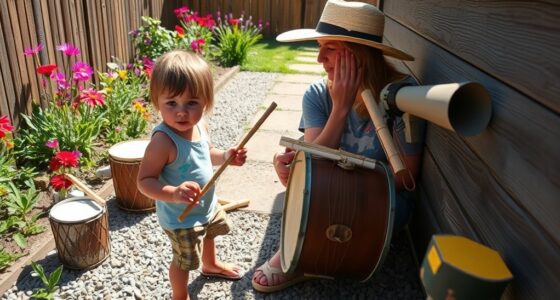Sensory play involves engaging children actively with their environment through all five senses—sight, sound, touch, taste, and smell—to support cognitive and motor development. It helps children explore textures, temperatures, and weights, building neural pathways and enhancing sensory processing abilities. Activities like finger painting, playing with textured materials, or exploring water encourage curiosity and coordination. If you want to learn more about how sensory play benefits your child’s growth, keep exploring these essential developmental tools.
Key Takeaways
- Sensory play involves activities that engage a child’s senses—sight, sound, touch, taste, and smell—to promote exploration.
- It helps develop neural pathways essential for understanding and interacting with the environment.
- Tactile exploration, a key component, uses touch to investigate textures, temperatures, and weights.
- Sensory play enhances fine motor skills, spatial awareness, and sensory processing abilities.
- Incorporating multi-sensory activities supports comprehensive cognitive and perceptual development.

Have you ever wondered how children explore and make sense of the world around them? It’s through a fascinating process called sensory integration, where their brains interpret signals from their five senses—sight, sound, touch, taste, and smell. Sensory play is an indispensable part of this process, allowing kids to engage with their environment actively. One of the key aspects of sensory play is tactile exploration, which involves using their sense of touch to investigate different textures, temperatures, and weights. When children plunge into tactile activities, they’re not just playing; they’re building essential neural pathways that help them understand their surroundings better.
Tactile exploration is fundamental to how kids develop their sense of touch and spatial awareness. When children touch, feel, and manipulate various objects, they’re receiving sensory input that helps their brains organize and interpret different textures and sensations. For example, running their fingers through sand, squishing playdough, or feeling the roughness of a sponge all contribute to sensory integration. These experiences help children differentiate between soft and hard, smooth and rough, hot and cold. The more varied their tactile exploration, the more their brains learn to process these differences effectively. This kind of sensory input is especially indispensable for children who may have sensory processing challenges, as it promotes calmness and focus when integrated correctly.
Engaging in tactile exploration isn’t limited to just feeling objects; it often involves hands-on activities that stimulate multiple senses simultaneously. For instance, finger painting combines visual and tactile senses, encouraging children to explore colors and textures at the same time. Similarly, playing with textured balls or sensory bins filled with rice, beans, or water provides opportunities for children to investigate different tactile qualities. These activities also foster fine motor skills, as children grasp, squeeze, and manipulate materials. As they do so, they’re strengthening their hand muscles and coordination, which are essential for later skills like writing and dressing. Additionally, incorporating varied sensory stimuli into play can significantly enhance neural development and sensory processing abilities.
Frequently Asked Questions
How Does Sensory Play Support Children With Sensory Processing Disorder?
You see that sensory play supports children with sensory processing disorder by promoting sensory integration, helping them better manage their responses. It encourages calmness through engaging activities that serve as calming techniques, reducing anxiety and overstimulation. By providing controlled sensory input, you help children develop coping skills, improve focus, and feel more secure in their environment, making sensory play an essential tool for supporting their unique needs and fostering overall development.
What Are the Best Age-Appropriate Sensory Play Activities for Toddlers?
Imagine opening your toddler’s curiosity with activities that are both fun and developmentally rich. You can introduce music therapy to stimulate their auditory senses and spark movement, or try art exploration with safe, tactile materials to enhance their touch and sight. These age-appropriate sensory play activities captivate toddlers, fostering learning and exploration while building essential skills—making every moment of play an exciting adventure they’ll eagerly crave.
Can Sensory Play Improve a Child’s Cognitive Development?
You might wonder if sensory play can boost a child’s cognitive development. It definitely can, as it promotes sensory integration, helping children process and respond to different stimuli. Engaging in sensory activities encourages problem-solving, improves focus, and enhances memory. By stimulating the senses through hands-on experiences, you’re supporting their cognitive benefits, laying a stronger foundation for learning and development. Sensory play truly nurtures your child’s growing mind.
How Do Different Textures Influence a Child’s Sensory Experiences?
Textures are like a child’s playground for their fingertips, shaping how they experience the world. When you encourage texture exploration, you boost tactile stimulation, helping children differentiate between rough, smooth, soft, or bumpy surfaces. Different textures ignite curiosity and support sensory development, making touch a gateway to learning. So, by providing various textures, you create a rich sensory environment where every tactile experience deepens their understanding and connection to their surroundings.
Are There Any Safety Concerns Associated With Sensory Play Materials?
When considering safety concerns with sensory play materials, always choose items made from non-toxic materials to protect your child from harmful chemicals. Be vigilant about choking hazards by avoiding small objects that could be swallowed or inhaled. Supervise play sessions closely, and regularly inspect materials for damage or wear. By prioritizing non-toxic options and eliminating choking risks, you guarantee a safe and enjoyable sensory experience for your child.
Conclusion
As you explore sensory play, remember it’s both simple and profound—like a messy finger paint masterpiece and a calming breeze on a summer day. While it sparks creativity and curiosity, it also nurtures your child’s development and emotional well-being. Embrace the chaos and calm alike, knowing that each touch, sound, and smell helps your little one grow stronger, more confident, and more connected to their world. Sensory play truly balances the fun and the growth.











